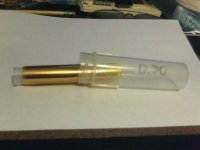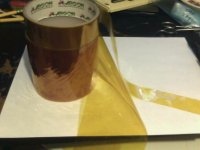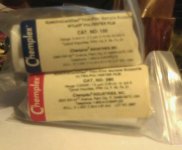Has anyone seen clear kapton? it usually has a copperish color. Mylar I thought was clear. Thanks
Kapton is Aramid an thus yellowish in colour, Mylar or PET is clear, PET is what you see in the fryingbags you use for cooking at turkey in the oven. Both materials are good for high(ish) temperatures (kapton best), both are rather hard stiff and strong materials. PET can be used for capacitors as it can be very thin <<3um, Kapton is not so good for that as it readyli absorbs moisture and as such it' not a very good dielectricum, Kapton cant be very thin <<12 um.
I have some Kapton.
I was supposed to post some pictures for you DeltaStar but I had got side tracked, Sorry. 😉
It can be gotten in small gauges as I have some .3 mil (7.5um) right here that is 2.875" wide.
I also have some 1mil that is 1" and 3" wide material.
I thought I had some .5 mil stuff but I do not.
I just verified the thicknesses with my micrometer.
The nice thing about kapton is that it can take the heat without shrinking and that is mainly why it is used in ribbon speakers.
I had originally got the stuff to make some ESL's for use in a automobiles that can survive the extreme Temperature changes without the tension changing.
So a mechanical stretcher is needed to make them, as it will not shrink and tighten up as I have already checked for this.
The melting point of this stuff is somewhere around 450 degrees Fahrenheit at which point it will then only melt.
I got these and some othe gauges of Mylar such as a very thin .1 mil (2.5um) and .06 mil (1.5um) Polyester (Mylar) as samples from Chemplex.
I used the .1mil stuff for my MicroESL driver that I made out of credit cards.
But, I haven't tried the thinnest .06 mil stuff yet.
Those pictures can be found here,
http://www.diyaudio.com/forums/planars-exotics/158115-material-esl-2.html#post2076459
Here is the link to Chemplex's Film's webpage,
XRF Sample Cup Thin-Film Sample Support Windows - Rolls & Pre-Cut Circles - Thin-Film | Chemplex Industries, Inc.
jer 🙂
P.S Sorry for the poor resolution of these photos as I used my webcam this time.
I misplaced the batteries to my digital camera!! Oooops!!! He,he,he,he 😉
I was supposed to post some pictures for you DeltaStar but I had got side tracked, Sorry. 😉
It can be gotten in small gauges as I have some .3 mil (7.5um) right here that is 2.875" wide.
I also have some 1mil that is 1" and 3" wide material.
I thought I had some .5 mil stuff but I do not.
I just verified the thicknesses with my micrometer.
The nice thing about kapton is that it can take the heat without shrinking and that is mainly why it is used in ribbon speakers.
I had originally got the stuff to make some ESL's for use in a automobiles that can survive the extreme Temperature changes without the tension changing.
So a mechanical stretcher is needed to make them, as it will not shrink and tighten up as I have already checked for this.
The melting point of this stuff is somewhere around 450 degrees Fahrenheit at which point it will then only melt.
I got these and some othe gauges of Mylar such as a very thin .1 mil (2.5um) and .06 mil (1.5um) Polyester (Mylar) as samples from Chemplex.
I used the .1mil stuff for my MicroESL driver that I made out of credit cards.
But, I haven't tried the thinnest .06 mil stuff yet.
Those pictures can be found here,
http://www.diyaudio.com/forums/planars-exotics/158115-material-esl-2.html#post2076459
Here is the link to Chemplex's Film's webpage,
XRF Sample Cup Thin-Film Sample Support Windows - Rolls & Pre-Cut Circles - Thin-Film | Chemplex Industries, Inc.
jer 🙂
P.S Sorry for the poor resolution of these photos as I used my webcam this time.
I misplaced the batteries to my digital camera!! Oooops!!! He,he,he,he 😉
Attachments
Last edited:
Kapton is Aramid an thus yellowish in colour
Not exactly. Aramids are polyamides- Kapton is a polyimide. Heat range is good, moisture absorption is mediocre (there are many worse), acoustical properties are not great (cellophane-crinkly), and tear propagation is poor.
Yes, always yellow or orange because of the imide functionality conjugated with the aryl.
- Status
- Not open for further replies.


